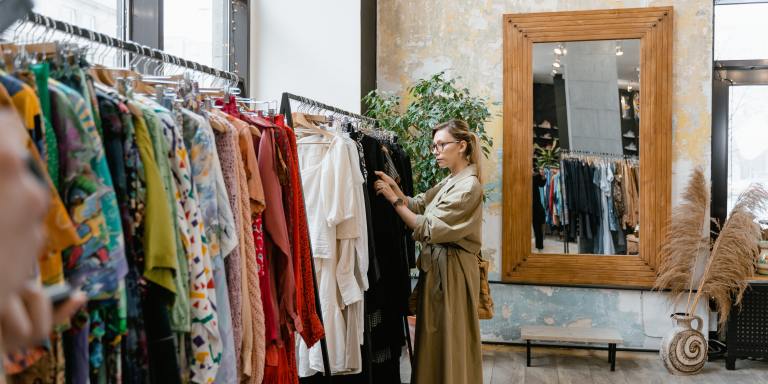1. While some Abercrombie locations are equipped with spritzers of Fierce (the brand’s signature cologne) built into the walls, many locations aren’t, and the employees are required to walk around at hour intervals and liberally spray every product and surface with the stuff. I happened to be in a location that got the best of both worlds, as we both had the spritzers and were encouraged to go on spray-runs throughout the day, lest everyone’s nostrils not be assaulted with the odor within a five-store radius.
2. The 90s-Eurodance-meets-gay-bar soundtrack consists of about 15 songs, and is looped mercilessly throughout the day. The tracks that were played when I worked there — including the remixes of “Gold” by Spandau Ballet, “Helpless When She Smiles” by Backstreet Boys, and “We Break The Dawn” by Michelle Williams, for the connoisseurs — are forever engraved on the surface of my brain.
3. Because A&F corporate consists of mostly goblins and lesser demons, they forced store managers to intentionally craft the schedule so as to keep people at the upper edges of part-time and therefore not eligible for health care. Yay!
4. Most of the store managers and a lot of the employees, at least at my location, held one or multiple degrees. And while there was still a certain amount of caché to the Abercrombie brand at that time, and people like my shift manager — who had a Master’s degree — chose to go there, they were still being paid near-minimum wage and had no access to health benefits.
5. Employees — referred to hilariously as ‘models’ — were sorted by appearance into various parts of the store. The thinner and more conventionally good-looking you were, the closer you were to the front. Ethnic minorities and overweight people most of the time went to work in the stock room, along with anyone who wasn’t tall or facially symmetrical enough to fold t-shirts.
6. I was one of the employees that was “scouted” while walking around my school’s campus, which essentially consists of a good-looking male manager coming up to you with a clipboard, telling you that you were pretty enough to work for Abercrombie, and that you should join the team.
7. Showing a good amount of skin on women was openly encouraged, in a way that would have constituted sexual harassment in nearly any other work environment.
8. We were frequently subjected to terrible internal corporate videos about why shoplifting is bad, and how to both prevent it in customers and discourage it amongst the staff.
9. Shoplifting customers were the norm. Many customers would come in with little machines to take off the security tags, and would flagrantly steal nearly everything they brought into the dressing room with them. Given that several managers had knives pulled on them when they attempted to chase down a thief, we generally responded to a smattering of security tags hidden behind a display with a resigned sigh. It was not something we were going to fight for.
10. Shoplifting was also a way of life for the employees. Between the terrible wages, the uncompensated overtime, and the lack of access to health care, most employees made their real income by stealing items and re-selling them on eBay. Some stole for personal use, usually the younger employees who were just there as a student job and therefore didn’t need the money as badly, but everyone stole.
11. We were all required to address every customer with “Hey, how’s it goin,” despite that being a completely ridiculous and inappropriate thing to say to a customer, especially the little old ladies who came in looking for button-downs for their grandsons.
12. Corporate shoppers frequently came in to nail us to the cross if we didn’t say the catchphrase when they walked in the door.
13. We were encouraged to pay more attention to more attractive customers, and to propose more revealing clothes to thinner people. One manager even told me, as his biceps strained the sleeves of his moose-emblazoned t shirt, that wearing Abercrombie was “a privilege, and not a right.” Ok, bro.
14. There was a rolling admission of ‘store models’ who were hot enough to become ‘model models,’ and we were constantly informed that the models on the billboards and shopping bags were actually just regular store employees, like us. The general understanding was that you went to upstate New York to some Terry Richardson-esque photo shoot for a week or so and then returned to your job folding sweaters. But we were never clear.
15. We were frequently told that offering help was “not our brand,” and that people need to come to us if they want to find something or ask a question.
16. I cannot recall a single time in which an employee actually went to the stock room, looked for something in earnest, and returned to the store floor with an actual answer.
17. It was something of a sport amongst the floor managers and employees to make fun of overweight and obese shoppers who came in looking for clothes, as we generally didn’t carry above a size 12 in most items, and were encouraged not to apologize for this.
18. Most of the non-English speaking workers in the stock room were on staff for a rolling schedule and would work upwards of 12 hours a day.
19. Technically we were given breaks, but were always encouraged by our shift managers to stay as close to the store as possible and not take more than 15 minutes to eat our lunch. If there was a heavy rush during normal lunch hours, we simply would not be given a break that day.
20. Because of the terrible lighting in the stores, customers would often purchase things with stains, tears, or other signs of damage on them, only to bring them right back when they got out into a decent amount of lighting. The goal was to refuse their return under the pretext that they had caused the stain themselves.
21. At least at our location, the (already negligible) employee discount did not extend to Hollister or the (now defunct) Ruehl, despite all being part of the same company.
22. Any employee who gained a significant amount of weight was fired, with little explanation. Not that you would have needed any, given that the overall environment regarding body image was not unlike the Ben Stiller character’s Globo Gym from the movie Dodgeball.
23. Very few employees lasted more than six months, given how awful the overall attitude of the workplace was. Several of us even quit in spectacular ways, ranging from walking away from the register during a holiday rush, to simply never coming in and never again answering your phone. Most people timed their departure against all of the clothes they were looking forward to stealing, and several ended up staying into the next season just to get a hold of a certain jacket or pair of jeans. Once they got their stuff, though, they were all gone. Bless the souls who are still slogging it out, and may the rampant theft be ever in your favor. ![]()






